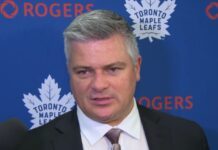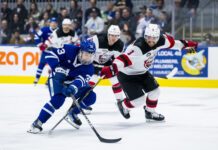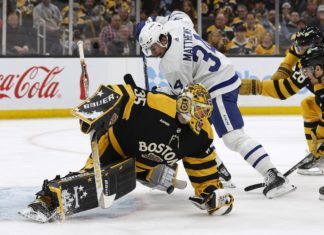Nearly a month into the 2016-17 season, what have we learned about the Toronto Maple Leafs so far?
The team is 5-4-3 to start. Their PP is seventh, their PK is ninth, they are ninth and tenth in Corsi and Fenwick respectively, and they’ve scored the seventh-most goals in the league while giving up the 4th most (good for a goal differential that ranks 17th). We know Mike Babcock puts a lot of stock into goal differential, so most of those other numbers won’t matter to him in comparison to the last one.
The Leafs were blown out one game — skewing the numbers when we’re only looking at a 12-game sample — and they also started the season with poor goaltending and played a really high-event brand of hockey offensively and defensively. Mike Babcock has focused on what the team gives up defensively in his press conferences. His challenge throughout the season comes in the balancing act of allowing his young players to be creative while also ensuring they manage the puck (therefore reducing the amount of shots and chances against). A few weeks ago, after getting crushed by Tampa Bay, Babcock touched on this topic:
“You have really elite players and they’re allowed to do different things at different times than other people because they can. They make decisions at the offensive blueline that other guys can’t because they can’t. In saying all that, they all have to know the score and the time, because that’s boss. Period. There’s a team time of your career and an individual time of your career. The individual time of your career is right at the start. You’re trying to make the team. You’re trying to become what you’re capable of becoming. These guys are all high-end players, though. They want to win. You think Auston Matthews or William Nylander or Mitch Marner like getting tattooed at home last night? They don’t. They don’t like turning the puck over and they don’t like being poor defensively and they don’t like making mistakes. None of them do. They want to be very good. We have a group of young guys like that. Today is a lesson, and I’ll tell you sometimes – no, not sometimes; probably most of the time – those lessons are better learned when things go bad than when things go good.”
On an individual level, the results have been promising. It was never in doubt, but Auston Matthews is the real deal and that requires no further explanation. William Nylander has picked up where he left off last season. Mitch Marner is quickly erasing any doubts anyone had about his NHL readiness — he has been a stud so far.
Just as Mike Babcock said last season, Zach Hyman and Connor Brown are NHLers. Nikita Soshnikov is, too. Meanwhile, the Leafs added two defensemen in Nikita Zaitsev and Connor Carrick, who both look like promising NHL players as well.
If the season ended today, the Leafs would technically make the playoffs (tied with Detroit and Philadelphia, but they have the tiebreaker as they’ve played one less game than both) and a Leaf would win the rookie of the year.
All that said, the rule of thumb is that an NHL team should wait until American Thanksgiving to really assess what it has. Toronto has eight games between now and then, and five of those opponents made the playoffs last season. The Leafs will face LA, Pittsburgh, and Florida, not to mention another road game in Montreal (who the Leafs have yet to beat since Babcock took over).
Babcock’s target this season is to collect six points every five games, which is roughly a 98-point season after 82 games. That would qualify for the playoffs.
The early returns suggest this is a team bursting with young talent, one that should be in the playoff race throughout the season. But there is a long way to go.
Notes
– In light of Saturday’s events, it’s interesting that seemingly every time Matthews’ line is on, so is Roman Polak. Hockey Analysis isn’t up to date at the moment so it can’t be quantified, but through the first seven games of the season, Matthews was the forward Polak played with the most, going on together for nearly half of all of Polak’s shifts.
– Polak, by the way, is second on the team in shorthanded ice time per game (3:27 on average, second to Marincin), and the Leafs PK is currently killing off 84.2% (ninth in the league). There are lots of calls for Frank Corrado to enter the lineup, rightly or wrongly, but Polak won’t be going anywhere based on that alone.
– In Detroit, Babcock fell in love with a grinder named Luke Glendening, giving him a key penalty killing role, relying on him for important faceoffs and using him as a match-up center. Sound familiar? It seems like Ben Smith has landed himself in the same sort of territory. He’s playing over 12 minutes per game as a Leaf, he is a main penalty killing forward, and he was even on to take key faceoffs in the final minute of the Edmonton game.
– One goal of the Leafs System Series this summer was to create a baseline for Toronto’s systems in order to evaluate the differences in play this season with more talent now in place. So far, the power play breakout has largely remained intact with the two-man drop pass through the neutral zone. It was also noted that the Leafs did the right things on the PP last season but simply lacked the talent. So far this season, the Leafs are clicking at 23.5% — good enough for seventh in the league to start. Nylander has seven PP points already; last season, Kadri led the team in PP scoring with 14.
– It has been interesting to watch how the Leafs have balanced Matthews and Nylander at the faceoff circle so far this year, culminating in Matthews having his first game of the year without taking a single draw on Saturday versus Vancouver.
| Matthews | Nylander | |
|---|---|---|
| Game 1 | 6/13 | 4/8 |
| Game 2 | 3/8 | 1/1 |
| Game 3 | 3/9 | 2/8 |
| Game 4 | 2/5 | 0/2 |
| Game 5 | 6/12 | 1/4 |
| Game 6 | 11/18 | 5/5 |
| Game 7 | 11/15 | 0 |
| Game 8 | 2/7 | 1/5 |
| Game 9 | 2/8 | 8/10 |
| Game 10 | 2/7 | 2/2 |
| Game 11 | 6/10 | 0/6 |
| Game 12 | 0 | 6/13 |
– It’s too early to say what faceoffs mean long-term in regards to whether Matthews and Nylander will play together for years to come or if they’ll be split up so each can play center. In Detroit, Babcock largely played Datsyuk and Zetterberg together in their primes, believing in playing his best players together. He taught that to then-assistant coach Todd McLellan, who carried the philosophy over to San Jose, where he united Joe Thornton and Patrick Marleau. Interestingly enough, Nylander was largely the center on Saturday against Vancouver. This will be something to monitor moving forward.
– Somewhat quietly, given it is Toronto: Brendan Leipsic has 15 points in 10 games (28 shots on goal) and Kapanen has 12 in 10 (34 shots on goal). Those are numbers that say, “I’m too good for this league and want to play in the NHL right now.”
Video Tidbit of the Week
Going forward, I will primarily use this section to note systems observations, set plays, faceoff plays, and the like. With that said, early in a season in which the head coach missed training camp and a bunch of rookies are adjusting to the NHL, I’d like to allow the Leafs’ structure and systems develop a little first.
Instead, I wanted to highlight this individual effort Nikita Soshnikov this week, showing off a few of the key things he brings to the team. Ultimately, nothing came of this play, but the net drive and ability to lower his shoulder and force his way to the net — on what was a nothing play — is part of what makes Soshnikov such a unique offensive player. This video is a good example of that fearless net drive, high-level puck protection, and some of his creative skill.
Quotes
I think we’re a little ahead. I think what we’ve seen from our young players, and how they’ve developed and how they’ve accepted the responsibilities they’ve been given… but you always have tongue in cheek. It’s only a half a dozen games right now. It takes a little while. We’ll have a better understanding of who we are and where we’re at after ten or fifteen games. To answer your question, I’d like to think we’re a little ahead.
- Lou Lamoriello, on where he thinks the team stands six games into the season.
The Leafs have now played 12 games and they look like a team that should expect to be in the playoff race throughout the season.
He’s another guy who I didn’t know – I mean, I knew he was a star; you can’t do what he did last year in junior hockey and not be a star that way – but I didn’t know if his size was going to be a real issue for him and affect him so much. It’s obviously not. He doesn’t get touched. He’s way stronger on the puck than you expect. He can drive the line as a winger. Most wingers can’t drive a line. He has the ability to do such.
- Mike Babcock on Mitch Marner
You never know what you’re going to get when a small, young player jumps into the NHL. So far, Marner has been very impressive.
Yeah, I don’t care too much about that. I mean, the game will be played the next time we play them and it will run its course I’m sure.
- Matt Martin’s reaction to a Canucks player shouting he “is dead,” presumably in reference to the next time the two teams play each other.
Mark your calendars: Saturday, December 3rd in Vancouver.
5 Things I Think I’d Do
1) I think I’d like to see the Matthews line shaken up a bit. Hyman is a really good player who does a lot of things well, including opening up space for Matthews and Nylander, and that is not to be taken for granted. He also has one point in 12 games. Like (I think) most people at this point, I’d be interested in seeing Soshnikov join those two — he brings similar forechecking abilities but he has a better shot and finishing abilities. One noticeable consequence of Hyman’s lack of a shot threat is that opponents are sagging off of him and completely focusing on Nylander and Matthews (rightfully so). Teams might sag off Soshnikov, too, but we know he can shoot and can make them pay.
2) I think I would keep Rielly-Zaitsev together for the foreseeable future. Zaitsev has adjusted to the league really well so far with six points in 12 games and a nearly 50% CF while playing 22 minutes a night and drawing tough match-ups. Since he’s been in the NHL, Rielly hasn’t had a good right-handed partner. With Zaitsev’s early promise along with the long-term commitment made to Rielly, I’d try my best to make the pairing work.
3) With an upcoming back-to-back this week (Friday at home vs. Philadelphia, Saturday on the road at Pittsburgh), I think I would start Enroth on Friday and Andersen on Saturday. There’s something to be said about taking the two points at home and saying “whatever happens happens” in the second half of a back-to-back with travel. Enroth is a good goalie, though. He’s more than capable of beating a good but not great Philly team at home, where the Leafs have played very well. Saturday night in the home rink of the Cup Champs is a good benchmark game for the team. I would want to set up my best roster for that game with no backup goalie excuse in place.
4) I think I would play Rielly more on the power play. Recently, the Leafs began using Carrick and Zaitsev together on the second unit, even though Rielly is tied with Zaitsev for points this season despite getting scraps for PP time. Rielly doesn’t have a better shot than any of the three defensemen playing PP over him, but where he separates himself is with his ability to quarterback the breakout thanks to his speed and decision making. There also seems to be this notion that they aren’t playing him on the PP to save him for tough even strength minutes – PP minutes aren’t tiring or difficult, and they allow everyone to have the puck on their sticks more than 5v5 play. It only builds confidence and helps players during the game.
5) I think, if the Leafs are really interested in preserving Rielly, they should give Gardiner more PK time (averaging five seconds per game) and reduce Rielly’s workload in shorthanded situations (2:37 per game). Gardiner hasn’t been featured on the PK since Babcock arrived (21 seconds per game last season), or basically at any point in the last four seasons. Gardiner’s strengths associate well with the PK, though – his skating allows him to maintain good gaps in the neutral zone and prevent clean entries, his stick work is good in his own end when it comes to blocking pass lanes, and he’s always been good at shot suppression in general. Even if you shave a minute off of Rielly’s total ice time on the PK that you can then use elsewhere (PP or otherwise), I’d argue it’s worth it all around. It wouldn’t hurt the PK, either.

































